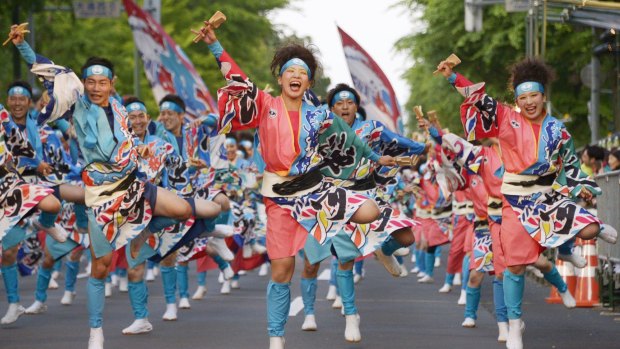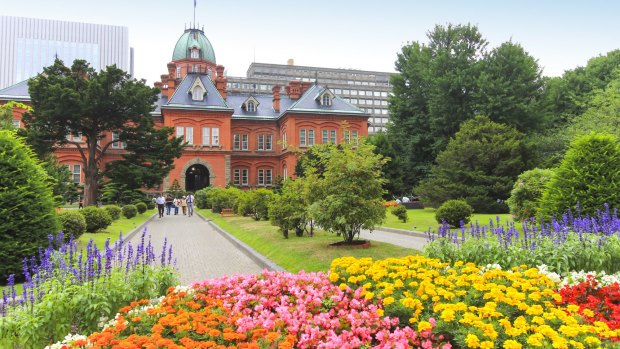
Dancers during the five-day Yosakoi Soran Festival.Credit: AAP
Within seconds of jumping into the gondola I'm whisked high up the mountain. The gondolas at Okurayama Ski Jump Stadium take two people a pop, so my husband and our guide Tosh are riding behind me. We're rapidly ascending, and although we'll be facing down the hill for the return leg, we all crane our necks as the view behind us is incredible, momentarily distracting us from the ski jump itself. I can't say that I've ever given ski jumping too much thought, but staring down at the steep ramp I get a little shot of adrenalin thinking of what it must be like to make a landing after such a huge leap.
When we reach Okurayama Observatory at the top of the hill, Tosh tells us that he learnt to ski jump at just four years of age and by the time he was a teen he was considered to be one of the best in the prefecture, even once considering trying out for the Olympics. Tosh doesn't elaborate any further and wanders off returning with three soft-serve ice-creams. "This is the best ice-cream in Sapporo," he says excitedly. "You will enjoy!" We all devour our sweet treats while admiring the views out to Sapporo city and beyond, with Tosh pointing out some of the sights we visited earlier in the day.
Japan is the first country my husband and I choose to visit with a new addition to the family, as it's generally considered to be safe, easy to get around and family friendly. We booked a few tailored tours and decided to cover the rest ourselves, exploring the island of Hokkaido first and then zooming down to Tokyo via Japan's newest Shinkansen route for big city buzz.

Sapporo's former Hokkaido Government Office is a slice of American architectural style in the northern Japanese city.Credit: Amthinkin
Tosh is our Sapporo city guide and he knows his stuff, cramming our day with information, but not rushing us around from point to point.
One of the city's most prominent sights – the former Hokkaido Government Office – is the first place Tosh takes us. It was one of the first American neo-baroque-style buildings to be built in the city and we take our time strolling around the exterior and admiring the red bricks and design intricacies – such as the warped glass that dates back to the Meiji Era (1868-1912) and the hefty double doors (built this way to keep the heat in during the cold winters). Tosh tells us the former government office was built in 1888 and designed to look a little like America's Massachusetts State House. Predictably, it was very different for its time and still remains as one of the most notable buildings in the city.
Inside is the tourism information centre and a museum with several collections, one of which is a small exhibition about the Ainu (an indigenous group of people who originate from Hokkaido and some parts of Russia). Tosh tells us it's estimated there are only about 45,000 Ainu people left worldwide, with about 20,000 of those living in Hokkaido and the remainder spread out across mainland Japan, Russia and other countries. He explains that at the beginning of the Meiji Era there was friction between the Ainu and the people of modern Japan, resulting in records of their lives being lost because they were not considered of great value.
For those interested in learning about the Ainu, Hokkaido is the best place. There's this museum inside the former Hokkaido Government Office; further north outside the small town of Shiraoi the outdoor Ainu Museum and cultural village is one of Japan's best exhibits (we visited while road tripping around Hokkaido); there's also a small display inside the Hokkaido University Botanical Gardens.
Tosh takes us to the botanical gardens later that day. It's a lovely place to stroll around for an hour or so, with most of the flora of the native variety. Some of the most impressive plants include an elm tree that is more than 100 years old and Sapporo's oldest lilac tree.
I'm fascinated by the somewhat unusual Northern Peoples Ethnobotanical Garden, where there are close to 200 plant species that were used by the northern peoples of east Asia (including the Ainu, as well as the Nivkh and Uilta), with explanations for their various traditional uses. Tosh translates some of the descriptions, pointing out which plants were used for food, medicine, handicraft and to assist with hunting. The Ainu exhibition can be found in the small museum on the second floor of the main office building, with a few artifacts on display made from the plants we'd just seen.
We decide to fit one more sight in before a late lunch, so head to Sapporo's oldest building – Sapporo Clock Tower – which was first used as a classroom space for Agricultural School students. The wooden pylon was built in 1878 and the clock installation came three years later, and like the former Hokkaido Government Office it was inspired by American design aesthetics.
Today there's a museum inside with exhibits covering the history of the building and Sapporo city, but I enjoy admiring the clock tower's exterior more. As we walk around the tower Tosh points out two red stars near the top of the roof, explaining they are a symbol of the Hokkaido Development Commission and that for locals they represent hope. I remember seeing a red star on the former Hokkaido Government Office and my husband says he saw one on the museum in the Hokkaido University Botanical Gardens.
We arrive at Jyogai Ichiba – which is the "kerb market" next to Sapporo Central Wholesale Market – for lunch. This is where locals and tourists alike shop for fresh or prepared seafood and Tosh assures us it's one of the best places to eat in town. After a quick stroll up and down the street we decide on a cosy restaurant and order the special – fresh sushi and crab sashimi – a Sapporo delicacy. We wash down our lunch with Sapporo beer and again come across that same red star on the packaging. It's an easy enough omen to decipher – we'll drink to Sapporo.
TRIP NOTES
STAY
Keio Plaza Hotel Sapporo is a convenient option, with comfortable rooms and an ideal location near Sapporo Station. See keioplaza-sapporo.co.jp/english/
FLY
Qantas flies to Tokyo from Sydney, Melbourne and Brisbane, connecting with Japan Airlines from Tokyo to Sapporo. See qantas.com and au.jal.co.jp/aul/en/
TOUR
Wendy Wu Tours offers bespoke tours, private tours and group tours through Japan. See wendywutours.com.au
MORE
Tatyana Leonov travelled as a guest of Wendy Wu Tours.
FIVE MORE THINGS TO DO IN SAPPORO
VISIT SAPPORO BEER MUSEUM AND SAPPORO BEER GARDEN
Japan's only beer museum is inside a beautiful red-brick building that dates back to the Meiji Era. Here you can learn about the history of Sapporo beer and the beer-making process. The Sapporo Beer Garden is next to the museum. Time to have lunch here after your museum visit and enjoy local beer teamed with Genghis Khan-style lamb. sapporo-bier-garten.jp
STROLL THROUGH ODORI PARK
In the middle of Sapporo, this lovely garden oasis stretches for more than a kilometre, with fountains and plenty of greenery in the summer. Still on the topic of beer, towards the end of July the park is transformed into one mammoth beer garden as part of Odori Beer Fest; Autumn Fest in September celebrates the kaleidoscope of oranges and reds that cover the city, with beer, food and music; the park also plays host to Japan's largest snow festival in February each year – Sapporo Snow Fest.
TRY SOUP CURRY
Sapporo is home to hundreds of restaurants specialising in soup curry, a delicious stew-like dish flavoured with spices and served with rice. Interestingly, soup curry originated in the early 1970s but only gained popularity in the early 2000s.
EAT SOFT-SERVE
Hokkaido is renowned for its high-quality dairy and you'll find soft-serve ice-cream around every corner in Sapporo. Start with vanilla if you must, but move on to interesting Asian-inspired flavours such as green tea, melon and lavender.
EXPLORE TANUKIKOJI SHOPPING STREET
This long shopping arcade stretches for close to one kilometre and is the place to go to buy souvenirs, knick-knacks and all kinds of quirky Japanese paraphernalia. There are plenty of restaurants to eat at, as well as karaoke bars if you're that way inclined.
Sign up for the Traveller Deals newsletter
Get exclusive travel deals delivered straight to your inbox. Sign up now.